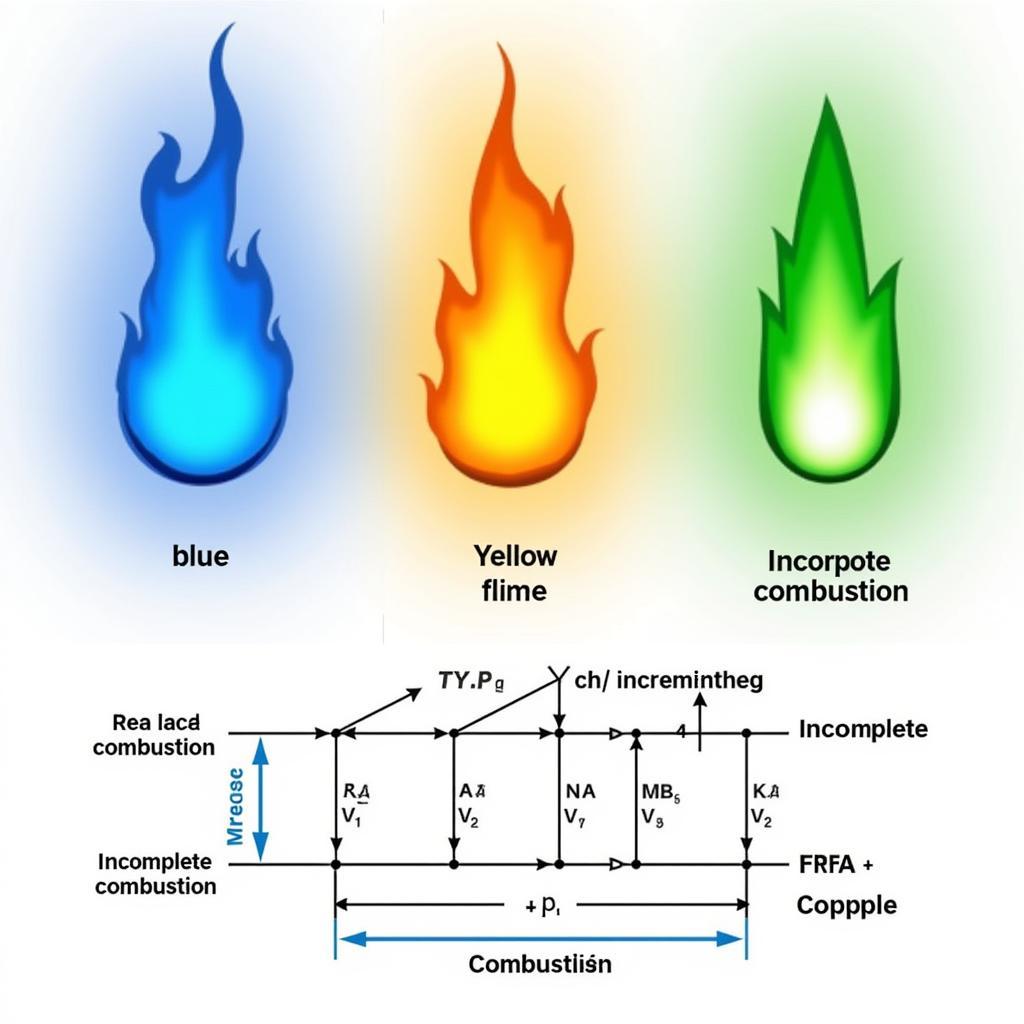Methane, a common greenhouse gas, burns with a predominantly blue flame. Understanding the color of a methane flame offers insights into its combustion process and can even help assess the efficiency of burning. This article will explore the science behind the blue hue, factors that can influence the flame’s color, and answer frequently asked questions about methane combustion.
Decoding the Blue Hue of a Methane Flame
The characteristic blue color of a burning methane flame is due to the chemical reactions occurring during combustion. When methane (CH₄) reacts with oxygen (O₂), it produces carbon dioxide (CO₂), water (H₂O), and heat. The intense heat excites the molecules within the flame, particularly CH and C₂ radicals. These excited molecules release energy as light, primarily in the blue part of the visible spectrum. This is why a properly adjusted methane flame appears blue.
Factors Influencing Methane Flame Color
While a pure methane flame burns blue, several factors can alter its appearance. Impurities in the methane supply, incomplete combustion, and the presence of other elements can change the flame color. For example, a yellow flame often indicates incomplete combustion, meaning not enough oxygen is available to fully react with the methane. This can produce soot (carbon particles), which glows yellow when heated.
Incomplete Combustion and Yellow Flames
Insufficient oxygen supply leads to incomplete combustion, producing a yellow flame and potentially dangerous carbon monoxide (CO). This is why proper ventilation is crucial when burning methane.
The Role of Temperature
Temperature also plays a significant role. A hotter flame will generally appear bluer, while a cooler flame might exhibit more yellow or orange hues. This is related to the types of molecules excited and the wavelengths of light they emit.
Other Elements and Color Variations
The presence of other elements can introduce different colors to the flame. For example, the presence of copper can create a green flame, while sodium can create a yellow-orange flame.
 Methane Flame Color Variations in Different Combustion Scenarios
Methane Flame Color Variations in Different Combustion Scenarios
Understanding Methane Combustion in Different Applications
Methane combustion is utilized in various applications, from household stoves to industrial furnaces. The color of the flame can provide valuable information about the combustion process in these different scenarios.
Methane in Household Appliances
In household appliances like stoves and water heaters, a blue flame signifies efficient combustion. A yellow flame indicates a problem that needs immediate attention, usually related to inadequate oxygen supply or a clogged burner.
Methane in Industrial Settings
In industrial furnaces and power plants, monitoring the flame color can help optimize combustion efficiency and minimize emissions. Sophisticated monitoring systems are often used to analyze flame color and adjust the fuel-air mixture for optimal performance.
Why is Knowing the Color of a Burning Methane Flame Important?
Understanding the color of a burning methane flame is important for safety and efficiency. A blue flame signifies complete combustion, minimizing the production of harmful byproducts like carbon monoxide. It also indicates efficient energy utilization. A yellow flame, on the other hand, warns of incomplete combustion, potential carbon monoxide production, and wasted energy.
What Happens When Methane Burns in a Limited Oxygen Supply?
When methane burns in a limited oxygen supply, incomplete combustion occurs. This results in a yellow flame, the production of soot, and the release of carbon monoxide, a poisonous gas.
Is the Blue Flame of Methane Hotter Than a Yellow Flame?
Generally, a blue methane flame is hotter than a yellow flame. The blue color indicates complete combustion, which releases more energy and results in a higher temperature.
Expert Insight: Dr. Emily Carter, Combustion Engineer
“The color of a methane flame provides a valuable visual cue about the combustion process. A bright blue flame signifies efficient, complete combustion, while a yellow flame indicates incomplete combustion and potential hazards.”
Expert Insight: Dr. David Miller, Environmental Scientist
“Incomplete methane combustion contributes to air pollution by releasing soot and carbon monoxide. Monitoring flame color is a simple yet effective way to ensure safe and efficient methane use.”
Conclusion
The color of a burning methane flame, primarily blue, offers important insights into the combustion process. Understanding the factors that influence flame color can help us ensure safe and efficient methane use in various applications. By recognizing the significance of a blue flame, we can optimize combustion, minimize harmful emissions, and maximize energy utilization. Remember, if you observe a yellow flame when burning methane, seek professional assistance to address the underlying issue.
FAQs
-
What causes the blue color in a methane flame? The blue color comes from excited CH and C₂ radicals releasing energy as light.
-
Why is my methane flame yellow? A yellow flame usually indicates incomplete combustion due to a lack of oxygen.
-
Is a blue methane flame hotter than a yellow flame? Yes, a blue flame is generally hotter, indicating complete and efficient combustion.
-
What are the byproducts of complete methane combustion? Complete combustion produces carbon dioxide and water.
-
Why is proper ventilation important when burning methane? Proper ventilation ensures sufficient oxygen supply and prevents the buildup of harmful byproducts like carbon monoxide.
-
What should I do if I see a yellow methane flame in my appliance? Contact a qualified technician to inspect and address the issue.
-
How can I ensure complete methane combustion in my appliances? Ensure proper ventilation and regular maintenance of your appliances.
Situations Where Flame Color Changes
- Yellow Flame: Indicates incomplete combustion, likely due to a lack of oxygen. Check for blocked vents or burner issues.
- Orange Flame: Might suggest dust or debris in the burner. Cleaning the burner can resolve this.
- Flickering Blue Flame with Yellow Tips: Could point to a slight issue with the gas supply or air mixture.
Related Questions and Further Reading
- What are the environmental impacts of methane combustion?
- How does methane combustion contribute to climate change?
- What are the different types of burners used for methane combustion?
Need Help? Contact Us!
For any assistance with methane combustion or related queries, contact us at: Phone: 0373298888, Email: [email protected] or visit us at: 86 Cầu Giấy, Hà Nội. Our customer support team is available 24/7.

